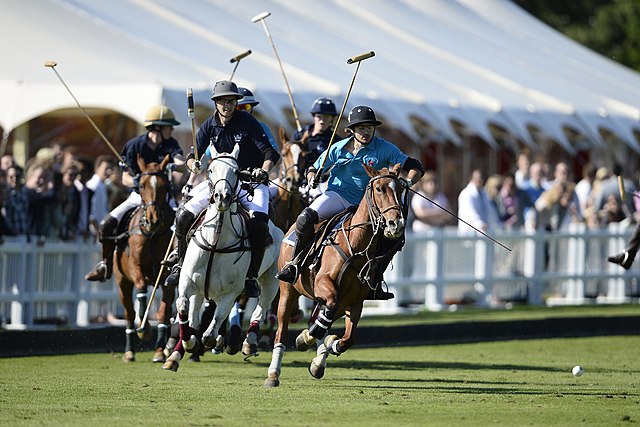Polo
Contributors to Wikimedia projects
 Article Images
Article Images
This article is about the sport. For other uses, see polo shirt, polo neck, VW Polo and Polo (mint).
Polo (also known as Cho-gan) is a team game played on a field with one goal for each team. Each team has four players. Polo features successive periods called "chukkas", and riders score by driving a ball into the opposing team's goal using a long-handled mallet. In this it is similar to many team sports such as football and field hockey. The main difference is that the players play on horseback.
History
“Let other people play other things – the king of game is still the game of kings”
This verse is inscribed on a stone tablet next to a polo ground in Gilgit, north of Kashmir, near the fabled silk route from China to the West. In one ancient sentence it epitomises the feelings of the players today.
Polo is arguably one of the most complex of games in the world. The precise origin of polo is obscure and undocumented and there is ample evidence of the game's regal place in the history of Asia. No one knows where or when stick first met ball after the horse was domesticated by the ancient Iranian (Aryan) tribes of Central Asia before their migration to Iranian plateau; but it seems likely that as the use of light cavalry spread throughout Iranian plateau, Asia Minor, China and the Indian sub-continent so did this rugged game on horse back. However, many scholars believe that polo originated among the Iranian tribes sometime before the reign of Darius the Great (521-485 BCE) and his cavalry forged the Second Iranian Empire, the Achaemenid dynasty. Certainly it is Persian literature and art, which give us the richest accounts of polo in antiquity.
Ferdowsi, the most famous of Iran’s poet-historian, gives a number of accounts of royal polo tournaments in his 9th century epic, Shahnameh (the Epic of Kings). Some believe that the Chinese (the Mongols) were the first to try their hands at the game, but in the earliest account, Ferdowsi romanticizes an international match between Turanian force and the followers of Syavoush, a legendary Persian prince from the earliest centuries of the Empire. The poet is eloquent in his praise of Siyâvash's skills on the polo field. Ferdowsi also tells of Emperor Sâpour-II of Sasanian dynasty of the 4th Century CE, who learn to play polo when he was only seven years old.
Polo has became popular among other nations such as Chinese, as was the royal pastime for many centuries. Chinese most probably having learned the game from the Iranians nobilities who seek refuge in Chinese courts after the invasion of Iranian Empire by the Arabs, or possibly by same Indian tribes who were taught by the Iranians. The polo stick appears on Chinese royal coats of arms and the game was part of the court life in the golden age of Chinese classical culture under Ming-Hung, the Radiant Emperor, who as an enthusiastic patron of equestrian activities.
For more than 20 centuries polo remained a favourite of the rulers of Asia, who played the game or were its patrons. Their Queens played, as did the nobility and the mounted warriors.
Polo for non-Iranians was the nearest equivalent to a national sport in those times, from Japan to Egypt, from India to Byzantium. As the great Eastern Empires collapsed, however, so disappeared the glittering court life of which polo has been so important a part, and the game itself was preserved only in remote villages
The sport became popular amongst European nobility but during the early part of 20th century, under the leadership of Harry Payne Whitney, polo changed to become a high-speed sport in the United States, differing from the game in England where it involved short passes to move the ball toward the opposition's goal. Whitney and his teammates used the fast break, sending long passes downfield to riders who had broken away from the pack at a full gallop.
Some other facts about the game:
External Links
- Buzkashi involves two teams of horsemen, a dead goat and few rules. The national game of Afghanistan and a likely precursor of polo.
- Polocrosse is another game played on horseback.
- Canoe polo is a polo game involving people in a canoe instead of on horseback.
- Water polo is a polo game played by people swimming in the water.
- Elephant polo is a polo game played by people riding elephants.
- Segway polo is a recently created polo game played on Segway HT scooters.